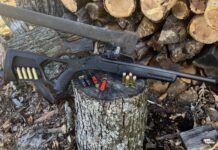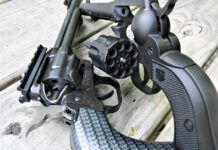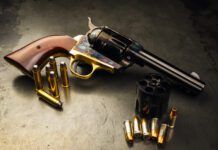The L. C. Smith Hammerless Double was first produced in Syracuse, New York, in 1886 by the L. C. Smith Gun Company, but in 1888, the company was bought by John Hunter, Sr., and was moved to Fulton, New York. This is where nearly half a million L.C. Smiths were manufactured by the Hunter Arms Company.
The graceful beauty and light construction of the L. C. Smith’s side-lock design have made it a very desirable shotgun for both the sportsman and collector alike, and with the recent conditional approval of bismuth shot, which eases many Smith owners’ worries about steel shot, many of these fine old shotguns will be brought back into service as waterfowl shotguns.
If you own a Smith and want to make it suitable to shoot again, or if you are presented a Smith to repair, here’s what you need to know about the shotgun.
Disassembling the L.C. Smith Shotgun
The L.C. Smith shotgun is very sensitive to dirt and foreign matter within its action. This is why cleaning and properly oiling the L.C. Smith is one of the most requested services on this shotgun. Its rotary bolt and extremely strong top lever spring make it a seemingly difficult shotgun to disassemble and put back together, so a good place to start any instruction on the L.C. Smith hammerless shotgun is its disassembly, cleaning, oiling and reassembly.
To begin disassembly, open the shotgun to ensure that it is unloaded and that it is cocked. Normally, gunsmiths want to be sure that a firearm‘s action is not cocked prior to disassembly, but the sidelocks of an L.C. Smith will be much easier to remove if the hammers are tucked out of the way as they are when cocked. The featherweight models have their lock assemblies attached by three screws, one in the front of each sideplate (attaching the plates to the frame) and a longer screw installed from the left plate (attaching the sidelocks to each other). The regular framed shotguns use only the longer screw.
Examine the longer screw before removing it. The threaded end should be relatively flush with the outside of the right plate. If it is not, this is a sign that the stock of the shotgun has shrunk and that the sideplates may be drawn too closely together by the torque of the rear screw. If this is the case, the plate assemblies will have to be rebedded. With a well fitted, parallel ground screw driver, remove all of the sidelock screws. Using the long screw as a handle, install it in the outside of the right sideplate and pull gently until the rear of the plate swings away from the frame.
Using either the long screw or a 1/8-inch punch inserted from the right and through the frame, push the left lock assembly away from the frame. I cannot stress enough the importance of using good screw drivers. Nothing could look worse on a fine double-barreled shotgun than screws that have been damaged by screwdrivers that do not fit.
Remove the trigger guard screws. With the safety off, the triggers should spring rearward and allow you to unscrew the trigger guard from the frame. Remove both the front and rear trigger plate screws.
Push the top lever to its open position and remove the screw beneath it. With the action upside down and secured in a vise and the top lever returned to its closed position, remove the screw attaching the trigger plate to the top lever. The shotgun is now apart. It may be necessary to lightly wiggle the butt stock to separate the trigger plate, frame and stock.
Common L.C. Smith Shotgun Repairs
The most common repairs I see on the L.C. Smith shotgun are broken firing pins, broken top lever springs, gummed and dirty actions (usually causing the rotating bolt to bind) and short chambers.
Broken firing pins are an easy fix. They are readily available through the Brownells catalog and from Gun Parts Corp. in New York, and can be easily made if necessary on the lathe.
In most of the L.C. Smith shotguns, the firing pins are easily removed by taking off the sidelocks. There is generally enough clearance between the stock and the firing pin to remove the firing pin without further disassembly. On some of the older models and on many of the higher grade shotguns, the firing pin is fitted in the receiver with a firing pin bushing. Removing the firing pin is easily done by carefully grinding a screw driver to fit the bushing.
There is no need for me to tell anyone how to clean a disassembled shotgun action. We all have our own techniques (every way from solvent and toothbrush to sonic cleaning systems). It is important however, that the cleaning operation be done thoroughly. When oiling an L.C. Smith (or any shotgun action), I like to first flood the working parts with a high quality gun oil, then blow as much of the oil as possible away with compressed air. This ensures that the shotgun action is thoroughly oiled, but not over oiled.
Checking Chamber Length
Checking the length of the chamber on the L.C. Smith (or any early American double gun) should be one of your first inspections. Chamber gauges are available from Brownells (or any good gunsmithing catalog) or they can be easily made on the lathe. The more chambers that you measure, the more you will realize that if the shotgun does not have 2 3/4″ stamped on it somewhere, it probably has short chambers.
I do all chamber lengthening in my shop with long forcing cone reamers. This not only ensures that the open shotshell does not extend into the forcing cone area (causing a partial obstruction and extremely high chamber pressures), but also gives the shotgun the benefits of a long forcing cone (still lower chamber pressure and less shot deformation of the pellets that are on the outside of the shot column).
I cannot stress enough the importance of any operation that reduces chamber pressure on early double guns. Our smokeless powders have come a long way since these shotguns were designed and built. Even a 2 3/4-inch, 1 1/4-ounce load, which is considered moderate by today‘s standards, is far more powerful than the shotshells that these shotguns were designed for.
The excessive recoil produced by the combination of modern ammunition and a short chamber will surely result in avoidable wear on both metal and wood. The chamber and forcing cone lengthening can be done easily by hand, using the instructions that the tool manufacturers provide with their reamers. In my shop we lengthen forcing cones and chambers on the lathe, an operation I’ll cover in more detail will be the subject of an article in the very near future).
The top lever spring is very easily installed in the disassembled receiver. This is an extremely strong V-spring; I advise that you buy one of these springs rather than try to make one. I have made a few of these springs, and although I consider myself an above average spring maker, I have had only limited success fashioned this spring myself.
The extremely strong V-spring in the bottom of the L.C. Smith receiver is the part that gives the gunsmith the most trouble in the shotgun’s reassembly. This is the spring that not only returns the top lever to its closed position, but also provides the energy to operate the L.C. Smith’s rotary bolt. When the trigger plate is removed, however, the bottom end of the top lever is no longer held in the center position by its locating hole in the trigger plate. Instead, it is forced to one side by the tremendous strength of the V-spring.
Aligning the bottom leg of the top lever with its hole in the trigger plate is the real challenge in reassembling this shotgun, but if you follow these simple instructions, you should have no trouble reassembling an L.C. Smith receiver.
First you will need to make a tool to hold the spring in a compressed position. My tool is made out of 4 to 6 inches of good, old-fashioned coat hanger. A 90-degree bend is made on one end of the tool, and this leg is cut to about one-quarter inch in length. At the other end, use some of the wire to make a comfortable handle. Put the receiver in your vise, upside down, and compress the top lever spring either with a pair of pliers or by pushing inward on the longer leg of the spring with a large screwdriver or bar.
Install the short leg of the tool between the long leg of the V-spring and the side of the receiver, with the tool‘s shaft perpendicular to the bore.
Now hold the stock of the shotgun up to the receiver and installed tool and mark the small relief cut that will have to be made in the stock to assemble the shotgun with the tool installed. Make this cut (as little as possible) with a file or Dremel tool. This will not weaken the butt stock in any way. When you have finished assembling the action around the spring compressing tool, it is easily removed by simply operating the top lever to relieve the spring pressure holding the tool in place.
Reassembling the L.C. Smith receiver is done quite easily with the receiver held upside down in the vise. It is helpful when installing the trigger plate to put the safety on at both its upper tang and trigger plate positions. This assures proper alignment as the components come together.
If you follow these steps, repairing these fine shotguns will be easier, and produce better results.





























DO YOU HAVE A VIDEO OF THIS?